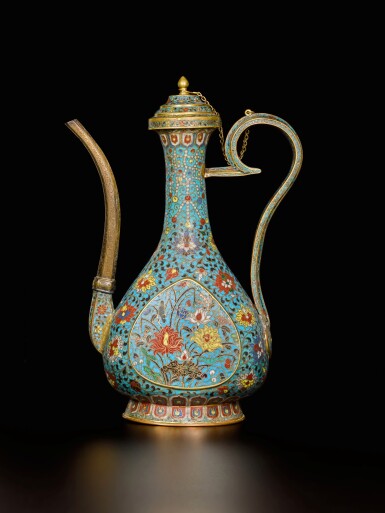Important Chinese Art
Important Chinese Art

Property from the Collection of Dr Kenneth Lawley (1937-2023) | Kenneth Lawley(1937-2023年)博士收藏
A rare cloisonné enamel pear-shaped ewer and cover, Ming dynasty, Jiajing period | 明嘉靖 掐絲琺瑯蓮塘紋執壺連蓋 《景泰年製》仿款
Auction Closed
November 1, 04:48 PM GMT
Estimate
20,000 - 30,000 GBP
Lot Details
Description
Property from the Collection of Dr Kenneth Lawley (1937-2023)
Kenneth Lawley(1937-2023年)博士收藏
A rare cloisonné enamel pear-shaped ewer and cover
Ming dynasty, Jiajing period
明嘉靖 掐絲琺瑯蓮塘紋執壺連蓋 《景泰年製》仿款
the base cast with an apocryphal Jingtai four-character mark
Height 33 cm, 13 in.
Cie. de la Chine et des Indes, Paris, 7th December 1970.
Bluett & Sons Ltd., London.
Collection of J. Chase Gilmore.
Anthony Carter, London, 8th August 2000.
Cie. de la Chine et des Indes,巴黎,1970年12月7日
Bluett & Sons Ltd.,倫敦
J. Chase Gilmore 收藏
Anthony Carter,倫敦,2000年8月8日
The Art Institute of Chicago, Chicago, 1974.
芝加哥藝術博物館,芝加哥,1974年
Originating with Islamic metal ewers, the form of the present piece was widely adopted during the Ming dynasty (1368-1644) with reproductions made in various materials, see, for example, several gold, silver and jade ewers, excavated from Ming tombs, illustrated in Yang Zhishui, 'Jinpingmei cihua zhong de jiu shi' [About wine in the novel Jin Ping Mei], Forbidden City, Beijing, 2016, pls. 21, 22 and 31.
The characteristic raised heart-, or peach-shaped medallion on the body is in Chinese literature sometimes described as representing a ginkgo leaf. This specific design is detailed in the Qing book Tianshui bingshan lu [A record of heavenly waters melting the iceberg], which lists the property of the wealthy but fallen Ming Senior Grand Secretary Yan Song (1480-1567). Ewers with such medallions decorated with lotus, like the present piece, are termed jinlian xingye hu (ginkgo leaf lotus decoration ewers).
Compare a closely related example, also with a Jingtai nian zhi seal mark from the E.T. Chow (1910-1980) collection, sold in our Hong Kong rooms, 19th May 1981, lot 612, and exhibited in Chinesisches Cloisonné. Die Sammlung Pierre Uldry, Rietberg Museum, Zurich, 1985, cat. no. 97, from the Pierre Uldry Collection; another decorated with the mythical beast qilin, in the British Museum, London is illustrated in Harry Garner, Chinese and Japanese Cloisonné Enamels, London, 1970, pl. 42; and one decorated with the Eight Buddhist Emblems, in the Victoria & Albert Museum, London, published in Basil William Robinson, Chinese Cloisonné Enamels, London, 1972, pl. 4. Compare also a related piece with pear-shaped body and hexagonal rim, included in the exhibition Cloisonné. Chinese Enamels from the Yuan Ming and Qing Dynasties, Bard Graduate Center, New York, 2011, cat. no. 58.
